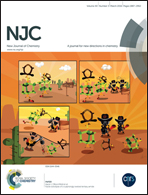Electrosynthesis and electrochemical capacitive behavior of a new nitrogen PEDOT analogue-based polymer electrode†
Abstract
In this work, poly(N-methyl-3,4-dihydrothieno[3,4-b][1,4]oxazine) (PMDTO), a new nitrogen poly(3,4-ethylendioxythiophene) (PEDOT) analogue, was synthesized by an electrochemical deposition method, and the capacitive properties of PMDTO were investigated and compared with those of PEDOT. The structure and morphology of PMDTO were characterized by ultraviolet-visible spectroscopy, Fourier transform infrared spectroscopy, scanning electron microscopy, and thermal analysis. The pseudocapacitive properties of the as-prepared PMDTO electrodes have been examined by cyclic voltammetry (CV), galvanostatic charge–discharge (GCD) measurements and electrochemical impedance spectroscopy (EIS) in 0.1 mol L−1 CH3CN–Bu4NBF4 electrolyte solution. The as-prepared PMDTO electrode showed a high specific capacitance of 154.3 F g−1 at a discharge current density of 3 A g−1 and exhibited cycling stability with the maximal capacitance retention of nearly 71% after 500 cycles at a high current density of 10 A g−1. Additionally, the asymmetrical supercapacitor based on PMDTO and PEDOT electrodes exhibited a maximum specific capacitance of 63.5 F g−1 and an energy density of 12.7 W h kg−1 at a power density of 0.59 kW kg−1. These results implied that the PMDTO electrode can be used as a potential electrode material for supercapacitors.


 Please wait while we load your content...
Please wait while we load your content...